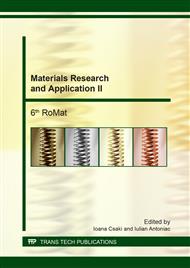[1]
Y. Li, C. Yang, H. Zhao, S. Qu, X. Li, Y. Li, New development of Ti-based alloys for biomedical applications, Materials, 7 (2014), 1709-1800.
DOI: 10.3390/ma7031709
Google Scholar
[2]
M.G. Minciuna, P. Vizureanu, M. Mares, V. Nastasa, D.C. Achitei, A.V. Sandu, Biocompatibility study of CoCrMoSik original alloy variants, Revista de Chimie, 67, 2 (2016), 362-365.
Google Scholar
[3]
M. Long, H.J. Rack, Titanium alloys in total joint replacement-A materials science perspective, Biomaterials, 19 (1998), 1621–1639.
DOI: 10.1016/s0142-9612(97)00146-4
Google Scholar
[4]
W.F. Ho, C.P. Ju, J.H. Chern Lin, Structure and properties of cast binary Ti-Mo alloys, Biomaterials, 20 (1999), 2115-2122.
DOI: 10.1016/s0142-9612(99)00114-3
Google Scholar
[5]
M. Niinomi, M. Nakai, Titanium-based biomaterials for preventing stress shielding between implant devices and bone, Int. J. Biomater., 836587, (2011).
DOI: 10.1155/2011/836587
Google Scholar
[6]
M.S. Bălţatu, P. Vizureanu, M.H. Ţierean, M.G. Minciună, D.C. Achiţei, Ti-Mo Alloys used in medical applications, Advanced Materials Research, 1128 (2015), 105-111.
DOI: 10.4028/www.scientific.net/amr.1128.105
Google Scholar
[7]
D. Mareci, R. Chelariu, I. Dan, D.M. Gordin, T. Gloriant, Corrosion behaviour of β-Ti20Mo alloy in artificial saliva, Journal of Materials Science: Materials in Medicine, 21, 11 (2010) 2907-2913.
DOI: 10.1007/s10856-010-4147-9
Google Scholar
[8]
D. Bombac, M. Brojan, P. Fajfar, F. Kosel, R. Turk, Review of materials in medical applications, Materials and Geoenvironment, 54, 4 (2007), 471 - 499.
Google Scholar
[9]
M. Geetha, A.K. Singh, R. Asokamani, A.K. Gogia, Ti based biomaterials, the ultimate choice for orthopaedic implants—A review, Prog. Mater. Sci., 54 (2009), 397– 425.
DOI: 10.1016/j.pmatsci.2008.06.004
Google Scholar
[10]
G. Bolat, D. Mareci, R. Chelariu, J. Izquierdo, S. González, R.M. Souto, Investigation of the electrochemical behaviour of TiMo alloys in simulated physiological solutions, Electrochimica Acta, 113 (2013), 470–480.
DOI: 10.1016/j.electacta.2013.09.116
Google Scholar
[11]
J.E.G. González, J.C. Mirza-Rosca, Study of the corrosion behavior of titanium and some of its alloys for biomedical and dental implant applications, Journal of Electroanalytical Chemistry, 471, 2 (1999) 109 - 115.
DOI: 10.1016/s0022-0728(99)00260-0
Google Scholar
[12]
W.F. Ho, C.P. Ju, J.H. Chern Lin, Structure and properties of cast binary Ti–Mo alloys, Biomaterials, 20, 22 (1999), 2115 - 2122.
DOI: 10.1016/s0142-9612(99)00114-3
Google Scholar
[13]
M. Niinomi, Mechanical properties of biomedical titanium alloys, Mater. Sci. Eng., A, 243 (1998), 231 - 236.
Google Scholar
[14]
Q. Chen, G.A. Thouas, Metallic implant biomaterials, Materials Science and Engineering R, 87 (2015) 1–57.
Google Scholar


